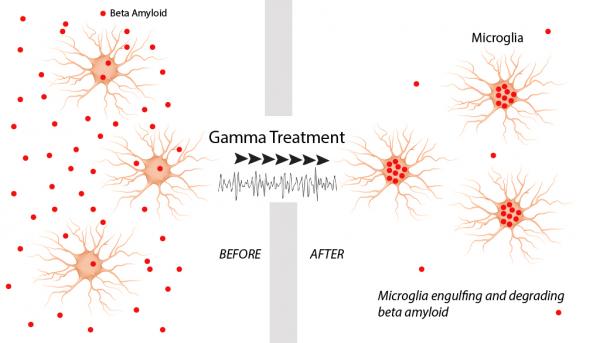A new breakthrough discovery by a team of scientists, which includes Annabelle Singer, assistant professor in the Wallace H. Coulter Department of Biomedical Engineering at Georgia Tech and Emory, has found that modifying oscillating gamma brain waves substantially reduces the build-up of beta amyloid plaques which are closely associated with Alzheimer’s disease. Singer was the co-lead author of the MIT research team that recently published its findings in the journal Nature this December.
Scientists have known that certain diseases negatively affect normal brain wave activity, particularly the type known as gamma oscillations which are in the range of 30-90 Hz. These oscillations are associated with neural processes that include learning and memory; the disruption of these oscillations is associated with Alzheimer’s disease, brain trauma, and schizophrenia. This disruption may be contributing to the build-up of beta amyloid proteins (plaques) — a common hallmark of Alzheimer’s disease.
Success with a series of biochemical, neural modifications to improve gamma activity and reduce beta amyloid build up in mice transitioned to the idea of using a noninvasive light technique to induce the same brain wave modification. Previous research showed that flickering light at specific frequencies induced gamma oscillations in the brain.
To the delight of researchers, this noninvasive flickering light treatment delivered at a specific frequency to induce gamma oscillation brain waves suppressed beta amyloid production and invigorated microglia — immune cells responsible for eliminating plaque buildup.
“We found that gamma brain waves were weaker in mice programmed to develop Alzheimer’s, even before plaques built up and mice had memory problems,” said Singer. “That led us to wonder if we could drive gamma brain waves to alter amyloid, the protein that accumulates in Alzheimer’s and forms plaques.”
When the researchers drove gamma, using both optogenetics and non-invasive light flicker, they found amyloid levels were drastically reduced.
“We found that driving gamma had two beneficial effects,” Singer said. “First, amyloid production slowed down. And second microglia, immune cells that act like trash collectors in the brain, changed so that they collected more amyloid.”
Alzheimer’s disease is an irreversible, progressive brain disorder that slowly destroys memory and thinking skills and, eventually, the ability to carry out the simplest tasks. More than five million Americans have Alzheimer’s disease and unless it can be effectively treated or prevented, the number of people affected will increase significantly as current population growth continues. Alzheimer’s is currently ranked as the sixth leading cause of death in the United States.
“While there are many steps to go to translate these discoveries in mice to a therapy for humans with Alzheimer’s, we think this radically different, non-invasive approach is very promising,” Singer said. “We are working hard on the next steps: Figuring out the most effective way to non-invasively drive gamma in brain regions essential for learning and memory and testing out this approach in humans.”
Media Contact:
Walter Rich
Communications Manager
Wallace H. Coulter Department of Biomedical Engineering
Georgia Institute of Technology
Media Contact
Media Contact:
Walter Rich
Communications Manager
Wallace H. Coulter Department of Biomedical Engineering
Georgia Institute of Technology
Keywords
Latest BME News
Commercialization program in Coulter BME announces project teams who will receive support to get their research to market.
Courses in the Wallace H. Coulter Department of Biomedical Engineering are being reformatted to incorporate AI and machine learning so students are prepared for a data-driven biotech sector.
Influenced by her mother's journey in engineering, Sriya Surapaneni hopes to inspire other young women in the field.
Coulter BME Professor Earns Tenure, Eyes Future of Innovation in Health and Medicine
The grant will fund the development of cutting-edge technology that could detect colorectal cancer through a simple breath test
The surgical support device landed Coulter BME its 4th consecutive win for the College of Engineering competition.
New research from Georgia Tech helps doctors predict how therapies will interact with a child's immune system, potentially improving outcomes and reducing risks.









